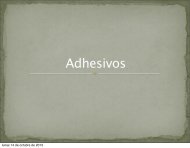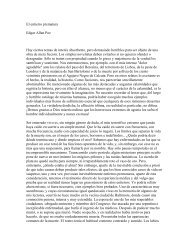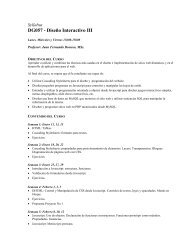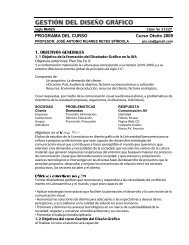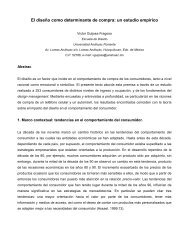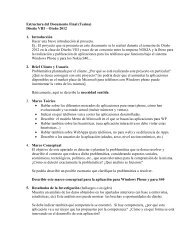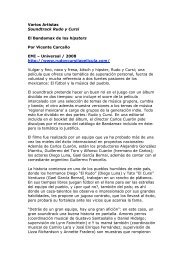Diseño sin FronterasHofste<strong>de</strong>´s cultural dimensions in Design projectsThe urge to contemplate cultural issues in projects of<strong>de</strong>sign was recognized and reiterated by Marcus & Gould.In their work “Cultural dimensions and global web <strong>de</strong>sign:what? so what? now what?’ (2001), the authors illustrate,through the Hofste<strong>de</strong>´s cultural dimensions, how specificcharacteristics of societies can be incorporated intowebsites.Based on the fact that the internet allows a global distributionof products and services, Marcus & Gould argue thatelectronic pages, if well <strong>de</strong>signed “transform simple usersinto clients”. In or<strong>de</strong>r to achieve such goal, the websiteshould be a<strong>de</strong>quate to users, culturally as well (2001, p.28).To give us examples, Marcus & Gould present possibleinfluences of Hofste<strong>de</strong>´s dimensions on a website interface. Consi<strong>de</strong>ring, for instance, the dimension powerdistance, the authors say the following aspects shouldbe incorporated: Highly structured information access to countries withhigh level of power distance, less structure informationAccess to those with lower levels; Focus on expertise, authority, specialists, certifications,official logos and stamps; Distinction among lea<strong>de</strong>rs and citizens, clients an<strong>de</strong>mployees; Security and restriction or explicit access barriers; Social rules as means to organize information.Regarding the individualism and collectivism dimension,Marcus & Gould consi<strong>de</strong>r that the influences on the <strong>de</strong>signof websites would be presented in the following aspects: Motivation based on personal acquisition maximizedto individualist societies; to those collectivist, motivationbased on the group achievements; Images of success represented through materialismand consume, in opposition to realization of social andpolitical programs; Focus on the individual in opposition to productsintroduced by a group of people; Sense of social morality; Prominence given to youth and action, in oppositionto maturity and experience.Concerning the dimension that relates masculinity andfemininity, websites to masculine cultures should focuson: distinction among gen<strong>de</strong>rs, family and age; navigationoriented to exploration and control; attention obtainedthrough games and competition. On the other hand,feminine cultures may have websites focusing on: balanceddistribution of roles between the gen<strong>de</strong>rs, cooperation,mutual support and exchange and attention obtainedthrough poetry, visual aesthetic and appeal to unifyingvalues.Consi<strong>de</strong>ring the uncertainty avoidance dimension, theauthors say that websites <strong>de</strong>signed to cultures with highUA level, societies with low tolerance to unknown andambiguous situations, should emphasize: simplicity, clearmetaphors, limited options and data; structured navigationschemes; mental mo<strong>de</strong>ls and help systems with focus onreduction of user errors; reduction of ambiguity throughspecific color traits, typography, sound, etc. Websites<strong>de</strong>signed to societies with low UA level, the focus might bein opposite elements, such as: complexity with a greaternumber of choices and content; risks acceptance an<strong>de</strong>ncouragement; less navigation control; mental mo<strong>de</strong>lsand help system with emphasis on the comprehension ofimplied concepts; color codification, typography and soundto maximize information.Illustrating the dimension long-term and short-termorientation, websites to countries with high LT level shouldbe <strong>de</strong>signed contemplating: content oriented to thepractice and to practical values; relationships as informationsource and credibility; patience in or<strong>de</strong>r to achieveresults and goals. To countries with low UA levels, websitesmay emphasize: content with focus on truth and certaintyof beliefs; rules as source of information and credibility andsearch for immediate results.To Marcus & Gould, assessing and exploring cultural dimensionswill be mandatory actions in or<strong>de</strong>r to be successfulboth on theory and practice of interface <strong>de</strong>sign.Marieke Mooij, Cross-Cultural Communication Consultant,reiterates that global and homogeneous markets do notexist because event people with similar life styles do notbehave as a consistent group of consumers, once they donot share the same values (2003, p.9). Mooij explains thatthe acquisition and the sensitiveness to certain productsattributes can be motivated by the person´s culture.Through the cultural dimensions of Geert Hofste<strong>de</strong>, Mooijhave research over 16 countries aiming at <strong>de</strong>fining whichcharacteristics and benefits should be incorporated intoproducts in or<strong>de</strong>r to have them culturally appropriate.The outcomes pointed out, for instance, thatsocieties with high power distance levels value productsthat reflect status. On the contrary, societies with low levelsvalues products that show informality. Luxury items wouldbe more attractive to masculine culture societies then tofeminine culture societies because they symbolize materialsuccess (Mooij, 2003, p.139).29
MX Design Conference 2011Mooij teaches us that, through the uncertainty andavoidance dimension, it is possible to explain the relationbetween culture and necessity of purity, for instance. Theauthor illustrates that Japan, country with high level ofuncertainty avoidance, consi<strong>de</strong>rs hygiene an importantrequirement due to its connection with security and healthmaintenance. Thus, there is in that country a great varietyof products and technologies with focus on cleanness,bacterial extermination, etc.Another example refers to people from cultures with highlevel of individualism, weak uncertainty avoidance andshort-term oriented. They value products and servicesthat provi<strong>de</strong> comfort and promptness: “frozen food, foodprocessors, microwaves and drive-ins” (Mooij, 2003, p.143)Cultural implications for the <strong>de</strong>sign practice: achallengeIn the introduction of the International Journal of Designspecial edition, Sato & Chen point out the enormousnumber of users, from different cultural backgrounds, thatinteract with each other through the new technologies andthe internet. The authors agree that the “incorporation ofcultural factors in <strong>de</strong>sign thinking and <strong>de</strong>sign processesis critical to achieve the high quality of human-artifactinteraction that enables our experience with the artifactto be effective and convivial”. Reiterating the importanceand gaps of cross-cultural studies in the Design field, somequestions were raised (Sato & Chen, 2008, p.1):How should we consi<strong>de</strong>r cultural factors in the <strong>de</strong>sign of artifacts?How will people in a cultural group accept new artifacts or technologies?How will new artifacts or technologies impact our culture? Howcan dominant cultural influences be i<strong>de</strong>ntified? How do multiplecultures interact during user-artifact interaction?Cross-cultural studies, as we inten<strong>de</strong>d to <strong>de</strong>monstratein this paper, may bring some answers to these questionsand may provi<strong>de</strong>, also, theoretical and methodologicaltools that could be and must be incorporatedto the creation process, planning, <strong>de</strong>velopment andassessment of products and services to target publicscomposed of people from different cultures.As said by Jorge Frascara, cross-cultural studies mightbring, also, answers to Design actions committed to:the <strong>de</strong>velopment and un<strong>de</strong>rstanding of people andpeople interactions, not people and object interaction;and to the “good will, tolerance of diversity andconsciousness about the value of life”. (Frascara 2001,p.18; 2000, p.127)BibliographyAIGA. The professional association of <strong>de</strong>sign. Disponívelem: http://www.aiga.org/. Acesso em: 13 <strong>de</strong> novembro<strong>de</strong> 2009._______. The Professional association of <strong>de</strong>sign.Center for cross-cultural <strong>de</strong>sign. Disponível em:http://www.aiga.org/content.cfm/cross-cultural<strong>de</strong>sign?searchtext=cross%20cultural%20<strong>de</strong>sign.Acessoem 13 <strong>de</strong> novembro <strong>de</strong> 2009._______. The Professional association of <strong>de</strong>sign. Center forCross-Cultural Design (AIGA|XCD). An AIGA Chapter andCommunity of Interest. Disponível em: http://xcd.aiga.org/manifesto.html. Acesso em 4 <strong>de</strong> outubro <strong>de</strong> 2010._______. AIGA. The Professional association of <strong>de</strong>sign.Defining the <strong>de</strong>signer of 2015. Disponível em: http://www.aiga.org/content.cfm/<strong>de</strong>signer-of-2015. Acessoem: 4 <strong>de</strong> outubro <strong>de</strong> 2010.BENNETT, J.M. Cultivating Intercultural Competence. IN: Thesage book of intercultural competence. Edited by DarlaK. Deardorff. Sage Publications, Inc. Estados Unidos.542p. P.121-140. 2009.CALDEIRA, A. L. N. A importância do programa <strong>de</strong> intercâmbioacadêmico na formação do jovem universitário:o caso da PUC-Rio. 85p. Monografia (Bachareladoem Ciências Sociais) - <strong>Departamento</strong> <strong>de</strong> Sociologiae Política, Pontifícia Universida<strong>de</strong> Católica do Rio <strong>de</strong>Janeiro. Rio <strong>de</strong> Janeiro, 2008.FRASCARA, J. Diseño gráfico para la gente: comunicaciones<strong>de</strong> masa y cambio social. 1ª ed. 1997. 4ª reimpressão.Ediciones Infinito Buenos Aires. Argentina. 2008. 270p.____________. The <strong>de</strong>materialization of <strong>de</strong>sign: anew profile for visual communication <strong>de</strong>sign. IN:Tipográfica50, pp 18-25. Novembro, 2001.___________, Information <strong>de</strong>sign and cultural difference.In: Information Design Journal. Publicado porInformation Design Journal. Milton Keynes, vol.9 # 2-3,pp. 119-127. 2000.HALL, E.T. The power of hid<strong>de</strong>n differences. In: BasicConcepts of Intercultural Communication: SelectedReadings. Milton Bennett (Org.) Intercultural Press. Inc.Estados Unidos. p.53-68. 1998.HOFSTEDE, G.; HOFSTEDE, J.H. Cultures and organizations:software of the mind: intercultural cooperation and itsimportance for survival. McGraw-Hill; 2a edição. EstadosUnidos,McGraw-Hill. 429p. 2005.30
- Page 2 and 3: MX Design Conference 2011Diseño si
- Page 4 and 5: ÍndiceCapeltic, una experiencia in
- Page 6 and 7: Diseño sin FronterasCapeltic, una
- Page 8 and 9: Diseño sin FronterasInvestigacione
- Page 10 and 11: Diseño sin Fronteras2) Una Empresa
- Page 12 and 13: Diseño sin Fronteras Se trabaja co
- Page 14 and 15: Diseño sin FronterasAhora bien, al
- Page 16 and 17: Diseño sin Fronteraslas personas a
- Page 18 and 19: Diseño sin FronterasDe esta manera
- Page 20 and 21: Diseño sin FronterasTercera fase:
- Page 22 and 23: Diseño sin FronterasDesign & Cultu
- Page 24 and 25: Diseño sin Fronteras Ideological p
- Page 26 and 27: Diseño sin Fronterasmain objective
- Page 30 and 31: Diseño sin FronterasJORDAN, P., De
- Page 32 and 33: Diseño sin Fronterasour personalit
- Page 34 and 35: Diseño sin FronterasThe Color in D
- Page 36 and 37: Diseño sin FronterasDesign in Teac
- Page 38 and 39: Diseño sin FronterasWe introduce t
- Page 40 and 41: Diseño sin Fronterasintellectual b
- Page 42 and 43: Diseño sin FronterasDesign Laborat
- Page 44 and 45: Diseño sin Fronterassustainable de
- Page 46 and 47: Diseño sin Fronteras4) Web design
- Page 48 and 49: Diseño sin Fronterasdemonstrating
- Page 50 and 51: Diseño sin Fronteraswith an encomp
- Page 52 and 53: Diseño sin FronterasDesign, Cultur
- Page 54 and 55: Diseño sin Fronterasb. Clothing: c
- Page 56 and 57: Diseño sin Fronterasappropriate fo
- Page 58 and 59: Diseño sin FronterasReferencesAPPA
- Page 60 and 61: Diseño sin Fronterasconocimiento 3
- Page 62 and 63: Diseño sin FronterasEntre los resu
- Page 64 and 65: Diseño sin FronterasOncología. Di
- Page 66 and 67: Diseño sin FronterasDistributed Co
- Page 68 and 69: Diseño sin Fronteras3 COLS: Web-ba
- Page 70 and 71: Diseño sin Fronterasoutcome, ‘pr
- Page 72 and 73: Diseño sin FronterasTable 1. List
- Page 74 and 75: Diseño sin Fronterasin which they
- Page 76 and 77: Diseño sin FronterasWithout attent
- Page 78 and 79:
Diseño sin Fronterasexample, the d
- Page 80 and 81:
Diseño sin Fronteras(fig.1). Despu
- Page 82 and 83:
Diseño sin FronterasEl diseño est
- Page 84 and 85:
Diseño sin Fronteras1. Ser un medi
- Page 86 and 87:
Diseño sin FronterasEl diseño est
- Page 88 and 89:
Diseño sin Fronterascionados con l
- Page 90 and 91:
Diseño sin FronterasR&.)''$--)'"&+
- Page 92 and 93:
Diseño sin FronterasSegún la inve
- Page 94 and 95:
Diseño sin Fronterasde educación
- Page 96 and 97:
Diseño sin FronterasEnfoque y meto
- Page 98 and 99:
Diseño sin FronterasLos esquemas p
- Page 100 and 101:
Diseño sin FronterasWireframes - S
- Page 102 and 103:
Diseño sin FronterasEstos efectos
- Page 104 and 105:
Diseño sin Fronterasa special ques
- Page 106 and 107:
Diseño sin Fronteras“cool” tre
- Page 108 and 109:
Diseño sin Fronterasy por esta raz
- Page 110 and 111:
Diseño sin Fronterasindustrial. Va
- Page 112 and 113:
Diseño sin Fronterasmejor desempe
- Page 114 and 115:
Diseño sin Fronterasganancia econ
- Page 116 and 117:
Diseño sin Fronterasproposing solu
- Page 118 and 119:
Diseño sin Fronteras3. The first r
- Page 120 and 121:
Diseño sin FronterasInterdisciplin
- Page 122 and 123:
Diseño sin Fronterasu opor tunidad
- Page 124 and 125:
Diseño sin Fronterasla formulació
- Page 126 and 127:
Diseño sin FronterasInterdisciplin
- Page 128 and 129:
Diseño sin Fronterasreal de una or
- Page 130 and 131:
Diseño sin FronterasConclusionesHa
- Page 132 and 133:
Diseño sin FronterasEn numerosas o
- Page 134 and 135:
Diseño sin Fronterashace reflexion
- Page 136 and 137:
Diseño sin Fronterasocasiones no e
- Page 138 and 139:
Diseño sin Fronterascondición de
- Page 140 and 141:
Diseño sin FronterasLa psicología
- Page 142 and 143:
Diseño sin FronterasReferencias bi
- Page 144 and 145:
Diseño sin FronterasMetodologíaLa
- Page 146 and 147:
Diseño sin Fronterasvisión se com
- Page 148 and 149:
Diseño sin FronterasLa mediación
- Page 150 and 151:
Diseño sin Fronteraspermiten el ac
- Page 152 and 153:
Diseño sin Fronterassolo el 5% de
- Page 154 and 155:
Diseño sin FronterasFrías, J. (20
- Page 156 and 157:
Diseño sin FronterasLa noción de
- Page 158 and 159:
Diseño sin FronterasMirada de Muje
- Page 160 and 161:
Diseño sin Fronterasidentidades, d
- Page 162 and 163:
Diseño sin FronterasIntroducciónE
- Page 164 and 165:
Diseño sin Fronteraso revelan a tr
- Page 166 and 167:
Diseño sin FronterasCon respecto t
- Page 168 and 169:
Diseño sin Fronterasprofesional y
- Page 170 and 171:
Diseño sin Fronteras¿Qué es wiri
- Page 172 and 173:
Diseño sin FronterasWiring es una
- Page 174 and 175:
Diseño sin FronterasSources of inn
- Page 176 and 177:
Diseño sin FronterasFeatureDescrip
- Page 178 and 179:
Diseño sin FronterasEncoding relev
- Page 180 and 181:
Diseño sin FronterasThe new design
- Page 182 and 183:
Diseño sin Fronteraslearn by doing
- Page 184 and 185:
Diseño sin FronterasThe Open(d) Fr
- Page 186 and 187:
Diseño sin Fronterasdisseminate th
- Page 188 and 189:
Diseño sin Fronterascontrib- ute d
- Page 190 and 191:
Diseño sin FronterasThe same digit
- Page 192 and 193:
Diseño sin Fronterasque desde todo
- Page 194 and 195:
Diseño sin FronterasFigura 4 refer





